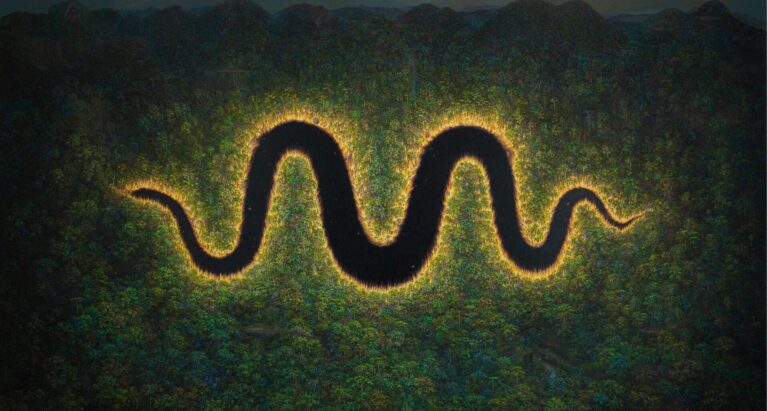In ‘Attention is the Fire’, PK Umesh paints a frighteningly enchanting ecosphere of extremes.
It is an enchanting and magnetic painting – Attention is the Fire. The painting by PK Umesh, displayed at the Lokame Tharavadu (The World is One Family) art exhibition in Kerala’s Alappuzha, will entrance you with its scale, composition, colour and imagery. It is like a god’s eye view of the world; a gaze from above; of a dense forest that is burning from the middle; a raging fire is spreading out from its heart, flaming out as if to swallow the whole forest in its fury.
A virtual tremor passes through the spine as one watches the scene. The whole picture is filled with intricately painted foliage – branches, trunks, leaves, etc. seen from above – of a thick, dense and verdant green vegetation. At the centre of the woods, dark and deep, a fiery fire, in the shape of a serpent, is burning its way through; it appears like a huge snaky burning and burnt ravine in the middle of the forest or an expanding and poisoning scar that erases everything organic, living and fertile in its deadly crawl.
The forest in all its diverse green and variety of foliage is painted in intricate, intimate detail, leaf by leaf, branch by branch, foliage by foliage, and tree by tree. An immense silence looms large and low over them, pressing upon it like the weight and burden of our gaze. As one moves nearer towards this painting, the image gradually envelops, engulfs and entrances us, drawing us into a kind of epiphanic experience.
It is an out-of-the-body feeling about the world, life and history. A haunting experience about the end of the world as it were, it is as if we are brought face to face with our biosphere. What emanates from the scene is a sense of doom, spectacular and riveting, a nightmare reminding us about the state of the earth, the fragility of our life and the planetary existence as a whole.
Fire for thought
In human imagination and mythologies, fire symbolizes passion, desire, destruction and hell as well as purification, resurrection, hope and rebirth. It made civilization possible but is also capable of destroying everything. So, what is it that is burning its way through this dense ecosphere? Is it the boon or curse of fire? Is it a warning, a premonition or a nightmare?
This world devoid of humans but thick with living vegetation and raging fire provides a strange and interesting contrast with one of the earlier exhibitions titled ‘Excavated Memories’ that Umesh has done. It was an assemblage of archaeological drawings, maps and excavated objects, rock edicts etc that the artist created with his own hands. It was an excavation into an imaginary land of his own, an extinct bygone civilization from which he has salvaged shards of memories, remnants of things, bits and pieces of ruins to ‘piece together’ imagined geography, landscape, people, life and culture.
In that show, Umesh was creating imaginary archaeology and the museum of objects and maps were about a state of human existence that is erased from physical existence or belongs to some remote past, and has to be gathered from the material evidence it had left behind.






This painting series exists in the other extreme. These dense forests and landscapes too are devoid of human presence, but they evoke the Human very strongly and intensely. This cannot be a pre-historic site; it can only be a nightmarish vision of the End or about a post-human world, vegetating and annihilating on its own. Or they may be visions of ‘shooting star on the distant horizon of the mindscape’.
Umesh sums it up in his note: “Imageries of my works belong to a world of mythopoeia. In the momentary lapse of reason, they appear as shooting stars on the distant horizon of the mindscape. The stroke of such visions instantly frees me from the grasp of the pattern of mundane thoughts. They flashlight into our deeper interior world and reveal that the individual is not a closed system but a focus in the collective mind. The impact left by such moments may linger inside over a period of time and if necessary, gives way for a pictorial articulation. I present my work as a device which can turn the viewer inwards in order to behold our inner reality.”
It is an invitation for us to turn inwards – to an inward journey that will awaken us to the Outside and to the fragility of the planet. The tremors we feel emanates from a kind of terrible beauty. A beauty that “gives you a fantastic, ‘impossible’ access to the inaccessible, to the withdrawn, open qualities of things, their mysterious reality.”(Being Ecological, Timothy Morton).




